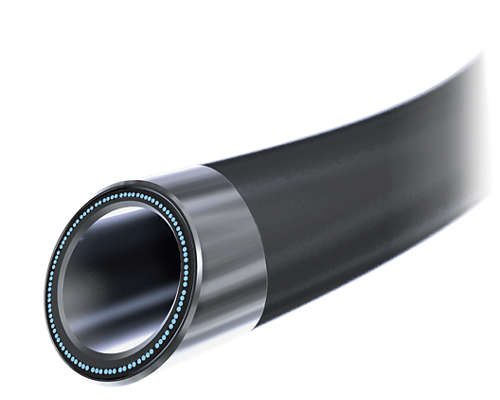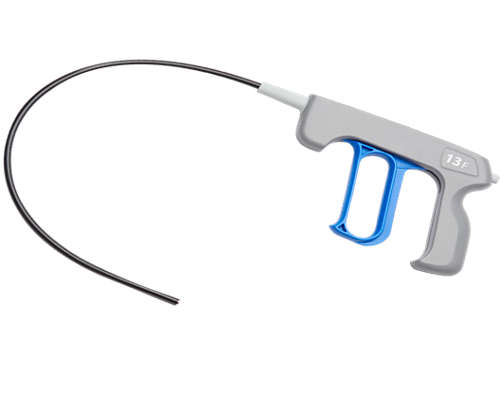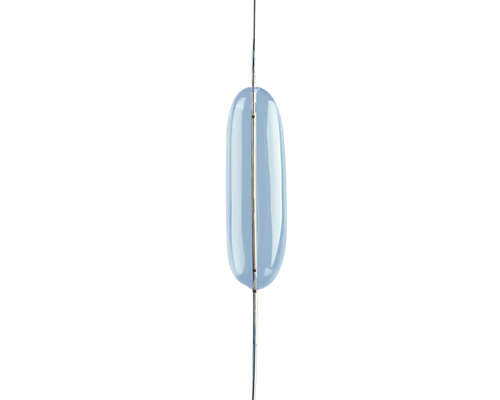Lead management devices and extraction
Take the lead. Advance patient care.
Philips is dedicated to helping physicians and patients manage every lead – safely, responsibly, predictably.
Demonstrated results in lead management devices and extraction
84%
Of patients with a noninfectious indication for lead extraction are capped1, leading to increased risk for infection2, higher risk future extraction3, contraindication for MRI4, and increased venous burdens.5,6,7
97.7%
Clinical success rate of laser lead extraction8
88.2%
Recent innovations have significantly advanced lead extraction. Proper use of the Philips Bridge occlusion balloon has contributed to increased SVC tear survival rates from 56.4% to 88.2%9
Featured products for lead management devices and extraction

GlideLight laser sheath
Safely and efficiently removing leads depends on tools that give you versatility and control. GlideLight laser sheath offers the ability to customize the laser’s repetition rate throughout a procedure. At 80 Hz, the GlideLight laser sheath requires up to 55% less advancement force,15 and advances up to 62% more efficiently through tough binding sites than SLS II.16

TightRail mechanical rotating dilator sheath
With TightRail, flexibility meets control. The tool’s flexible shaft helps physicians remain coaxial to the lead while maintaining forward progression through tortuous vasculature. The dilating blade remains shielded until activated, putting physicians in control and allowing counter-traction at the targeted lead’s distal tip.

Bridge occlusion balloon
A tear in the superior vena cava (SVC) during a lead extraction procedure is rare, occurring in just 0.5% of cases.9 But when a tear does occur, the Bridge occlusion balloon can be quickly deployed to stop blood loss and allow time for transition to surgical repair.14
“By removing the pacemaker, I’ve been able to get on with my life and be more optimistic about tomorrow, and I can live again.“
Jerry
Patient
Documentation
GlideLight laser sheath important safety information Always read the label and follow the directions for use. Philips medical devices should only be used by physicians and teams trained in interventional techniques, including training in the use of this device. Products subject to country availability. Please contact your local sales representative. ©2024 Koniklijke Philips N.V. All rights reserved. Trademarks are the property of Koninklijke Philips N.V. or their respective owners. Philips reserves the right to change product specifications without prior notification. [16] Comparison of ablation force vs. advancement rate of Laser sheath 40Hz vs. 80Hz by use of the data collected in D015786, Data on file at Spectranetics. [17] Blomström-Lundqvist, C. et al. European Heart Rhythm Association (EHRA) international consensus document on how to prevent, diagnose, and treat cardiac implantable electronic device infections—endorsed by the Heart Rhythm Society (HRS), the Asia Pacific Heart Rhythm Society (APHRS), the Latin American Heart Rhythm Society (LAHRS), International Society for Cardiovascular Infectious Diseases (ISCVID) and the European Society of Clinical Microbiology and Infectious Diseases (ESCMID) in collaboration with the European Association for Cardio-Thoracic Surgery (EACTS). Europace (2020) 22, 515–516 and European Heart Journal (2020) 41, 2012–2032
The GlideLight laser sheath is intended for use with other lead extraction tools in patients who are suitable candidates for removal of implanted pacemaker and defibrillator leads. The use of the GlideLight laser sheath may be unsafe in some patients, or with certain leads, or when the leads cannot be extracted through the superior veins (that is, when groin or surgical extraction is required). Rarely a patient undergoing lead extraction may require urgent surgical treatment for a complication; therefore, patients should not undergo lead extraction with a laser sheath in centers where emergency surgical procedures cannot be performed. Leads not intended for extraction may be damaged during the procedure and may require replacement. Ask your doctor if you are a candidate for lead extraction with the GlideLight Laser Sheath.
Potential minor adverse events associated with lead extraction procedures that may or may not require medical or surgical treatment include: a tear or damage to the blood vessels, the heart or its structures; bleeding at the surgical site; or collapsed lung. Rare but serious adverse events that require emergency medical or surgical procedures may include: a tear or damage to the blood vessels, the heart, lungs or their structures; blood clot or obstruction of the blood vessels or lungs by debris or lead fragments. Other serious complications may include: irregular heartbeat, weakened heart muscle, infection, respiratory failure or complications associated with anesthesia, stroke or death. This information is not intended to replace a discussion with your healthcare provider on the benefits and risks of this procedure to you.
[1] Pokorney et al. Outcomes Associated with Extraction versus Capping and Abandoning Pacing and Defibrillator Leads Circulation 2017 Oct 10;136(15):1387-1395. doi: 10.1161/CIRCULATIONAHA.117.027636. Epub2017 Aug 22.
[2] Chua, J.D., et al. (2000). Diagnosis and management of infections involving implantable electrophysiologic cardiac devices. Annals of Internal Medicine, 133(8): 604- 608.18.
[3] del Rio A, AngueraI, Miro JM, et al. Surgical treatment of pacemaker and defibrillator lead endocarditis: the impact of electrode lead extraction on outcome. Chest 2003;124:1451–9.19.
[4] Mattei, E., Gentili, G., Censi, F., Triventi, M. and Calcagnini, G. (2015), Impact of capped and uncapped abandoned leads on the heating of an MR-conditional pacemaker implant. Magn Reson Med, 73: 390–400. doi: 10.1002/mrm.25106
[5] Sohail, M. et al. (2014). Laser lead extraction to facilitate cardiac implantable electronic device upgrade and revision in the presence of central venous obstruction. Europace, 16(1), 81-87.
[6] Oginosawa Y, Abe H, Nakashima Y. The incidence and risk factors for venous obstruction after implantation of transvenous pacing leads. Pacing Clin Electrophysiol 2002;25:1605–1611.
[7] Kutarski, A., Pietura, R., Młynarczyk, K., Małecka, B., & Głowniak, A. (2012). Pacemaker lead extraction and recapture of venous access: technical problems arising from extensive venous obstruction. Cardiology journal, 19(5), 513-517.
[8] Chrostopher Aldo Rinaldi, Igor Diemberger, Mauro Biffi, Yu-Rong Gao, Enoch Sizto, Nancy Jin, Laurence M Epstein, Pascal Defaye, Safety and success of transvenous lead extraction using excimer laser sheaths: a meta-analysis of over 1700 patients, EP Europace, Volume 25, Issue 11, November 2023, euad298, doi.org/10.1093/europace/euad298
[9] Ryan Azarrafiy, BA; Darren C. Tsang, BS; Bruce L. Wilkoff, MD, FHRS; Roger G. Carrillo, MD, MBA, FHRS. The Endovascular Occlusion Balloon for Treatment of Superior Vena Cava Tears During Transvenous Lead Extraction: A Multi-Year Analysis and An Update to Best Practice Protocol. Circulation: Arrhythmia and Electrophysiology, August 2019.
[10] Pokorney SD, Zepel L, Greiner MA, et al. Lead Extraction and Mortality Among Patients With Cardiac Implanted Electronic Device Infection. JAMA Cardiol. Published online October 18, 2023. doi:10.1001/jamacardio.2023.3379
[11] Wazni, O et. al. Lead Extraction in the Contemporary Setting: The LExICon Study: A Multicenter Observational Retrospective Study of Consecutive Laser Lead Extractions, J Am Coll Cardiol, 55:579-586
[12] Margey, R. et al. Contemporary management of and outcomes from cardiac device related infections Europace (2010) 12 (1): 64-70 first published online November 11, 2009 doi:10.1093/europace/eup362
[13] Wazni O, Epstein LM, Carrillo RG, et al. Lead extraction in the contemporary setting: the LExICon study: an observational retrospective study of consecutive laser lead extractions. J Am Coll Cardiol. 2010;55(6):579-586.
[14] Document on file, D026197. In an animal model with SVC tears up to 3.5 cm, with 2 pacing leads and 1 ICD lead
[15] Comparison of average peak push forces required to advance Laser Sheath at 40Hz vs. 80Hz Pulse Repetition Rate through simulated fibrosis material at an advancement rate of 1.0 mm/second. D015722, Data on file at Spectranetics.

